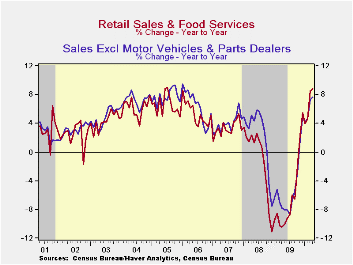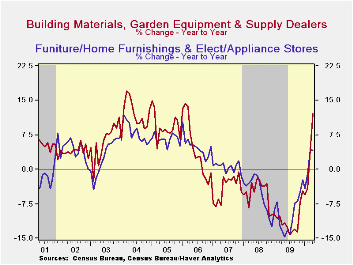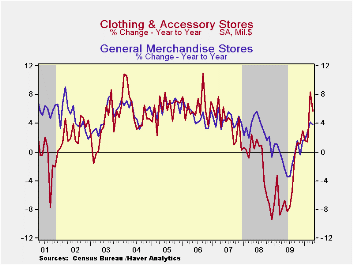 Global| May 14 2010
Global| May 14 2010U.S. Retail Spending Remains Firm; Core Sales Are Strongest Since 2006
by:Tom Moeller
|in:Economy in Brief
Summary
Improvement in the job market definitely has translated into more business for U.S. retailers. Retail sales rose 0.4% last month. The gain was twice the Consensus expectation and the March increase was revised up to 2.1% from 1.6% [...]

Improvement in the job market definitely has translated into more business for U.S. retailers. Retail sales rose 0.4% last month. The gain was twice the Consensus expectation and the March increase was revised up to 2.1% from 1.6% initially reported.Year-to-year, the 8.8% increase in sales was the strongest since 2005 although sales remained 3.6% below the pre-recession peak.
Nonauto sales also posted an expected 0.4% increase in April following two months of 1.2% gains. The March rise was double the advance indication. Bloating this increase was a 6.9% surge (12.1% y/y) in sales of building materials & garden equipment.
To the downside in April was "core" discretionary spending, though earlier gains are still improved. Apparel store sales fell 1.0% (+5.7% y/y), although they rose at a 15.3% rate during the last three months. Sales at furniture, home furnishings & electronics stores also fell by 0.8%, but the three-month change actually rose by 9.3% after two years of decline. Furniture sales alone declined 1.2% following two months of 2.0%+ increases. Sales of electronics & appliances fell for the second consecutive month. However, as a result of a strong beginning to the year, three-month sales increased at a 5.5% annual rate. Finally, sales at general merchandise stores slipped 0.4% (+3.9% y/y) but they rose at a 5.7% rate during the last three months.
Despite the decline in unit sales, motor vehicle sales rose 0.5% last month and at a 19.5% rate during the last three. Finally, sales at gasoline service stations rose just 0.5% (30.1% y/y) despite a 2.8% rise (39.0% y/y) in April gas prices. Are higher prices discouraging usage?
Earlier strength in internet & catalogue sales continued to abate. Sales ticked up just 0.2% and the three-month annualized rate of gain backed off further to 3.0% down from 25.3% growth in January.


| April | March | February | April y/y | 2009 | 2008 | 2007 | |
|---|---|---|---|---|---|---|---|
| Total Retail Sales & Food Services (%) | 0.4 | 2.1 | 0.6 | 8.8 | -6.0 | -0.8 | 3.3 |
| Excluding Autos | 0.4 | 1.2 | 1.2 | 7.6 | -4.8 | 2.4 | 3.9 |
| Non-Auto Less Gasoline | 0.4 | 1.3 | 1.3 | 5.1 | -1.9 | 1.6 | 3.6 |
Tom Moeller
AuthorMore in Author Profile »Prior to joining Haver Analytics in 2000, Mr. Moeller worked as the Economist at Chancellor Capital Management from 1985 to 1999. There, he developed comprehensive economic forecasts and interpreted economic data for equity and fixed income portfolio managers. Also at Chancellor, Mr. Moeller worked as an equity analyst and was responsible for researching and rating companies in the economically sensitive automobile and housing industries for investment in Chancellor’s equity portfolio. Prior to joining Chancellor, Mr. Moeller was an Economist at Citibank from 1979 to 1984. He also analyzed pricing behavior in the metals industry for the Council on Wage and Price Stability in Washington, D.C. In 1999, Mr. Moeller received the award for most accurate forecast from the Forecasters' Club of New York. From 1990 to 1992 he was President of the New York Association for Business Economists. Mr. Moeller earned an M.B.A. in Finance from Fordham University, where he graduated in 1987. He holds a Bachelor of Arts in Economics from George Washington University.






